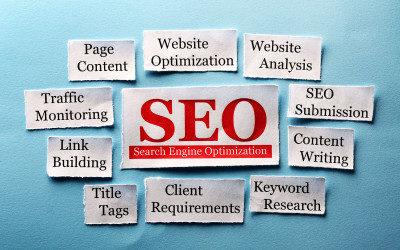In the world of digital marketing, capturing the attention of website visitors is paramount. The hero image, headline, and call to action (CTA) are crucial elements that can make or break the success of your website. As an expert SEO copywriter, I’m here to share insights on how to create powerful and persuasive hero image headlines and CTAs that engage your audience and drive conversions. By understanding the key principles and implementing effective strategies, you can optimize your website for maximum impact.
Crafting a Concise and Compelling Headline
The hero image headline serves as the gateway to your website’s content, making it a critical element in capturing your visitors’ attention. Here, we’ll delve deeper into the key principles of creating a concise and compelling headline that effectively engages your audience.
1. Keep it Concise
In a fast-paced digital world, brevity is essential. Aim for a headline length of approximately 6 to 10 words. Shorter headlines are easier to digest, make an immediate impact, and grab the reader’s attention quickly. Avoid long and convoluted sentences that can overwhelm or confuse your audience. By distilling your message into a concise headline, you increase the chances of capturing your visitors’ interest and enticing them to explore further.
2. Use Strong, Action-Oriented Language
To create a compelling headline, use strong and action-oriented language that evokes emotions or curiosity. Incorporate powerful verbs that inspire action, such as “Discover,” “Unleash,” “Transform,” or “Ignite.” By employing vibrant and energetic language, you create a sense of urgency and excitement, encouraging visitors to engage with your content. Focus on the benefits or unique selling points of your product or service, ensuring that your headline resonates with your target audience.
3. Highlight a Clear Benefit or Unique Selling Point
Your headline should immediately convey the value your product or service offers. Highlight a clear benefit or unique selling point that sets you apart from competitors. What problem do you solve? What makes your offering unique or superior? By addressing these questions in your headline, you capture the reader’s attention and provide them with a compelling reason to explore further. It’s crucial to communicate the value proposition succinctly and effectively, allowing visitors to quickly understand the benefits of engaging with your brand.
4. Incorporate Relevant Keywords
Optimizing your headline for search engines is essential to improve your website’s visibility and organic traffic. Conduct keyword research to identify relevant terms and phrases that align with your content and target audience’s search intent. Incorporate these keywords naturally into your headline, ensuring it remains compelling and engaging. However, avoid keyword stuffing, as it can harm the readability and effectiveness of your headline. Strike a balance between optimizing for search engines and creating an engaging headline that resonates with human readers.
5. Test and Iterate
Creating the perfect headline often requires testing and iteration. A/B testing allows you to compare different headline variations to determine which performs best. Experiment with different language, formats, and messaging strategies to identify the most effective approach. Test headlines with diverse segments of your target audience and measure key metrics like click-through rates and conversion rates. By collecting data-driven insights, you can continually refine and optimize your headline to improve its impact and effectiveness.
Wrapping It Up
Remember, a concise and compelling headline is a powerful tool to grab your visitors’ attention and entice them to explore your website further. By incorporating strong language, highlighting benefits, optimizing for search engines, and testing different variations, you can create a headline that effectively communicates your message, captivates your audience, and drives engagement and conversions.
Designing a Clear and Persuasive Call to Action
The call to action (CTA) is the driving force behind conversions on your website. It is the element that compels visitors to take a specific action, whether it’s making a purchase, signing up for a newsletter, or requesting more information. To create a clear and persuasive CTA, consider the following key principles:
1. Begin with a Strong Verb
Start your CTA with a strong, action-oriented verb that encourages immediate engagement. Examples of effective verbs include “Get,” “Discover,” “Start,” “Join,” “Shop,” or “Learn.” These verbs prompt users to take the desired action and create a sense of momentum. By using compelling verbs, you instill a sense of excitement and urgency, motivating visitors to act.
2. Keep the Language Concise and Clear
The language used in your CTA should be concise and straightforward, clearly communicating the desired action. Avoid using jargon or complex terms that might confuse your audience. Use simple, easily understandable phrases that leave no room for ambiguity. Make it clear what visitors will gain or achieve by following the CTA. For example, instead of “Click here,” use “Start your free trial” or “Download the e-book.”
3. Create a Sense of Urgency or Exclusivity
To drive immediate action, create a sense of urgency or exclusivity in your CTA. Incorporate words or phrases that convey limited availability or time-sensitive offers. Examples include “Limited Time Offer,” “Exclusive Access,” “Now,” or “Only.” By emphasizing the urgency or exclusivity of the offer, you motivate visitors to act promptly, fearing they might miss out on a valuable opportunity.
4. Utilize Power Words
Power words are persuasive terms that elicit an emotional response and evoke a sense of desire or curiosity. Incorporating such words in your CTA can make it more compelling. Examples of power words include “Effortless,” “Revolutionary,” “Proven,” “Guaranteed,” or “Instant.” These words trigger emotions and establish a stronger connection with your audience, increasing the likelihood of conversions.
5. Optimize for Visual Impact
The design and visual presentation of your CTA can significantly impact its effectiveness. Make sure the CTA stands out from the rest of the page by using contrasting colors, bold typography, or visual cues such as arrows or icons. The CTA button should be prominently displayed, easily identifiable, and visually appealing. Ensure that it is large enough to be easily clickable, especially on mobile devices, where touch interactions are common.
6. Test Different Variations
A/B testing is a valuable technique to optimize your CTAs. Test different variations of the CTA language, design, placement, and colors to determine which combination drives the highest engagement and conversions. Pay attention to metrics such as click-through rates, conversion rates, and bounce rates to gather insights into the performance of your CTAs. Continuously refine and iterate based on the data collected to improve the effectiveness of your CTAs over time.
Wrapping It Up
A clear and persuasive call to action is crucial for driving conversions on your website. By using strong verbs, clear language, creating a sense of urgency, incorporating power words, optimizing for visual impact, and conducting A/B testing, you can create CTAs that captivate your audience, prompt them to take action, and ultimately increase your conversion rates.
Aligning Visuals for Maximum Impact
When crafting an effective hero image headline and call to action (CTA), it’s crucial to ensure that the visuals within your website align seamlessly with your messaging. Here are some key considerations for aligning visuals to maximize their impact:
1. Relevant and High-Quality Visuals
Choose visuals that are not only visually appealing but also relevant to your brand, product, or service. Images should resonate with your target audience and convey the right message. Whether you opt for photographs, illustrations, or graphics, they should support and enhance the overall theme and tone of your website. Additionally, prioritize high-quality visuals to maintain a professional and polished appearance.
2. Consistent Branding
Maintain consistent branding throughout your hero image, headline, and CTA. Use colors, fonts, and design elements that align with your brand identity. Consistency helps create a cohesive visual experience for your audience and reinforces your brand image. Ensure that the visuals seamlessly integrate with your website’s overall design and style, establishing a cohesive and visually appealing user interface.
3. Visual Hierarchy
Establish a visual hierarchy that guides the viewer’s attention towards the headline and CTA. Use design techniques such as size, color contrast, and positioning to make the headline and CTA stand out. Consider using elements like arrows, lines, or other visual cues that direct the viewer’s gaze toward the desired action. By creating a clear visual pathway, you ensure that visitors can quickly and effortlessly understand where to focus their attention.
4. Emotional Appeal
Visuals have the power to evoke emotions and create a connection with your audience. Choose images that elicit the desired emotional response based on your brand and messaging. Whether you aim to inspire, excite, comfort, or motivate, select visuals that align with the emotional tone you want to convey. By evoking emotions through visuals, you can engage your audience on a deeper level and increase their willingness to take action.
5. Test Different Layouts and Design Variations
Experiment with different layouts and design variations to find the most effective combination. A/B testing can help you identify the visual elements that resonate best with your audience. Try different placements of the headline and CTA within the hero image. Test variations in the size, color, and style of the headline and CTA button. By collecting data and analyzing user behavior, you can refine your design choices to optimize the visual impact of your hero image and increase engagement.
6. Mobile Responsiveness
Ensure that the visuals, including the hero image, headline, and CTA, are optimized for mobile devices. With a significant portion of web traffic coming from mobile users, it’s vital to provide a seamless and engaging experience on smaller screens. Ensure that the visuals scale appropriately and that the text remains legible. Pay attention to the size and placement of the CTA button, making it easily clickable with a touch interface.
Wrapping It Up
Aligning visuals for maximum impact involves selecting relevant and high-quality visuals, maintaining consistent branding, establishing a visual hierarchy, appealing to emotions, testing different variations, and optimizing for mobile responsiveness. By strategically aligning visuals with your messaging, you can create a visually compelling user experience that effectively guides your audience toward your hero image headline and CTA, ultimately driving engagement and conversions.
A/B Testing and Optimization
A/B testing is a powerful technique that allows you to compare different variations of your hero image headline and call to action (CTA) to determine which performs better. By gathering data-driven insights, you can optimize these elements to maximize their effectiveness and drive higher conversion rates. Here’s a closer look at A/B testing and the optimization process:
1. Define Testing Goals
Before starting your A/B tests, clearly define the goals you want to achieve. It could be increasing click-through rates, improving conversion rates, or reducing bounce rates. Establishing specific objectives helps you measure the impact of your testing accurately and determine the success of different variations.
2. Identify Elements to Test
Select the elements you want to test within your hero image headline and CTA. This could include variations in language, design, layout, color schemes, button styles, or placement. Start with one element at a time to isolate its impact on user behavior. Testing multiple variations simultaneously can lead to confounding results.
3. Create Variations
Develop different versions of your hero image headline and CTA based on the elements you’ve identified. Ensure that each variation differs from the original version in a single, specific way. For example, you might test a different headline, CTA button color, or placement on the page. Keep other aspects consistent across variations to accurately measure the impact of the changed element.
4. Split Test Implementation
Divide your website traffic evenly between the different variations (the control and the variations) using A/B testing tools or platforms. Randomly assign visitors to each variation to ensure a statistically significant sample size. This approach ensures that external factors or user biases do not skew the results.
5. Monitor and Collect Data
During the A/B testing period, closely monitor and collect relevant data and metrics. Track key performance indicators (KPIs) such as click-through rates, conversion rates, bounce rates, or engagement metrics. This data will provide insights into how each variation performs compared to the original version.
6. Analyze Results
Once you have gathered sufficient data, analyze the results to determine the impact of each variation. Identify the variations that outperform the control and assess the statistical significance of the differences observed. Statistical significance helps validate that the improvements are not due to chance.
7. Implement and Iterate
Based on the results of your A/B tests, implement the variations that performed better than the control. This might involve updating your hero image headline, refining your CTA language, or adjusting the design elements. Continuously iterate and build upon the successful variations to further optimize your hero image and CTA for improved conversions.
8. Repeat and Scale
A/B testing should be an ongoing process. As you make changes based on the initial tests, continue testing new variations to refine your hero image headline and CTA further. Repeat the A/B testing cycle to validate new hypotheses and optimize your website continually. Scaling your optimized elements across multiple pages or campaigns can help maximize their impact on your overall conversion strategy.
Wrapping It Up
Remember, A/B testing and optimization require patience and rigor. It’s crucial to allow sufficient time for data collection and to test variations on a statistically significant sample size. Regularly review and update your hero image headline and CTA to stay aligned with user preferences, industry trends, and evolving business goals. By continuously testing and optimizing, you can drive ongoing improvements and maximize the effectiveness of your hero image and CTA to achieve higher conversion rates.
Mobile Responsiveness for Enhanced User Experience
With the growing prevalence of mobile devices, it’s essential to prioritize mobile responsiveness when designing your hero image headline and call to action (CTA). Mobile responsiveness ensures that your website adapts seamlessly to various screen sizes, providing an optimal user experience for mobile users. Here are key considerations for enhancing mobile responsiveness:
1. Responsive Design
Implement a responsive design approach that automatically adjusts your website’s layout, content, and visuals based on the user’s screen size. This ensures that your hero image, headline, and CTA are displayed correctly and legibly across different devices, such as smartphones and tablets. Responsive design eliminates the need for users to zoom in or scroll horizontally, providing a seamless and intuitive browsing experience.
2. Consistent Visual Elements
Maintain consistency in the visual elements of your hero image, headline, and CTA across different devices. The layout, colors, fonts, and button styles should remain consistent, allowing users to easily recognize and interact with your CTAs, regardless of the device they are using. Consistent branding and visual elements create a unified and professional image, enhancing user trust and engagement.
3. Legible Text
Ensure that the text in your hero image, headline, and CTA is legible on smaller screens. Consider the font size, line spacing, and contrast between text and background to optimize readability. Test your website on various mobile devices to confirm that users can easily read and understand the content without straining their eyes. If necessary, increase the font size and adjust line spacing to improve legibility on smaller screens.
4. Easy Clickability
Make your CTAs easily clickable on mobile devices, where touch interactions are common. Ensure that the CTA buttons are large enough to be tapped with a finger without accidentally tapping neighboring elements. Provide ample spacing around buttons to prevent accidental clicks. Optimize the touch target size to enhance user experience and reduce frustration, ultimately encouraging higher engagement and conversions.
5. Mobile-Friendly Forms
If your CTA involves a form, optimize it for mobile users. Mobile-friendly forms should have appropriately sized input fields, easy-to-select dropdown menus, and large, legible buttons. Use mobile-specific input options, such as numeric keyboards for number fields, to streamline the data entry process. Minimize the number of form fields to reduce friction and simplify the user experience, as lengthy forms can be cumbersome on mobile devices.
6. Performance Optimization
Mobile users often have limited bandwidth and slower internet connections, so optimize your website’s performance for quick loading on mobile devices. Compress images, minify CSS and JavaScript files, and leverage browser caching to reduce load times. Prioritize speed and performance to prevent users from abandoning your website due to slow loading times.
7. User Testing
Conduct user testing on various mobile devices and screen sizes to identify any usability issues or design flaws. Observe how users interact with your hero image, headline, and CTA on mobile devices and gather feedback on the overall user experience. Implement improvements based on the insights gained from user testing to enhance mobile responsiveness and address any usability concerns.
Wrapping It Up
By prioritizing mobile responsiveness, you create an enhanced user experience for mobile visitors, leading to increased engagement and conversions. Mobile-friendly design and optimization ensure that your hero image, headline, and CTA are visually appealing, accessible, and easy to interact with on smaller screens. Remember to regularly review and refine your mobile responsiveness strategy to adapt to evolving user preferences and technological advancements.
Conclusion
In the dynamic world of digital marketing, crafting effective hero image headlines and calls to action (CTAs) is crucial for capturing attention, conveying messages, and driving conversions.
By following the principles of concise and compelling headlines, clear and persuasive CTAs, aligning visuals for maximum impact, utilizing A/B testing and optimization, and prioritizing mobile responsiveness, you can create a powerful user experience that engages your audience and maximizes results.
Continuously refine and iterate your strategies, leveraging data-driven insights and user feedback to stay ahead of the curve. With a strategic approach to these elements, you can create a website that not only attracts visitors but also compels them to take action, ultimately fueling your business growth and success in the digital landscape.
- Google Shakes Up Digital World: Free Website Service No More! - January 8, 2024
- Unleashing the Power of Storyboarding: A Practical Guide to Designing Outstanding Websites - September 20, 2023
- Why Your Business Needs a Professional Web Consultant: A Comprehensive Guide - September 5, 2023




